


 About US Domain
About US DomainUS is the ISO-3166 2-letter country code for the United States and thus the US Domain is established as a top-level domain and registered in the same way as other country domains. Figure 1 shows the relationship between the US domain and other top level domains.
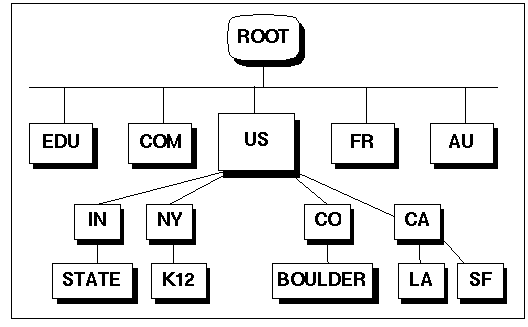
 Who can Register
Who can RegisterThe US Domain currently registers businesses, individuals, federal government agencies, state government agencies, K12 schools, community colleges, technical/vocational schools, private schools, libraries, museums, and city and county government agencies.
Any computer in the United States may be registered in the US Domain hierarchy. Generally, computers outside the United States are expected to register in other domains, however, there may be exceptions when a computer is used as part of a project or in a community with other computers in the US Domain.
 Naming Structure
Naming Structure
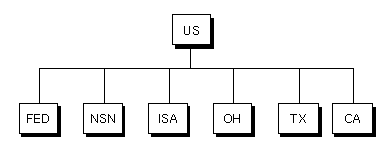
Generally, it is expected that a name will correspond to a physical computer and that a computer will have exactly one name.
For small entities like individuals or small businesses there is usually no problem with selecting locality based names. For example:
Under the city locality name space there is a "CI" branch for city government agencies (some localities may use other names such as TOWN, VILLAGE, BOROUGH, or PARISH). As usual, businesses and private schools may register directly under the city name.
In the case where there is both a county and a city with the same locality name there is no problem, since the names will be unique with the "CO" or "CI". For example, when the county has a fire department and the city has its own fire department, they could have names like:
An agency of the city government takes on the responsibility for the delegation of the domain (for example: CI.Ventura.CA.US) and can register all the other agencies under the CI code for the locality like Fire-Dept.CI.Ventura.CA.US. In the same way the county government can take the responsibility for the delegation (for example: CO.Ventura.CA.US) and register all the agencies under it like Fire-Dept.CO.Ventura.CA.US.
Acceptable locality names are those listed in the US Postal Service Zip Code Directory or a well known atlas.
There is no requirement, as far as the overall US domain administration is concerned, that the user of a "locality" US domain name actually be in or have any connection with that locality. For example, the user of Smith.Boston.MA.US could actually reside in New Hampshire.
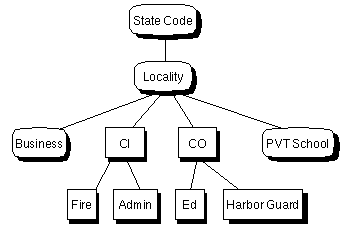
| riverdale-hs.K12.TN.US |
(Riverdale High School) | |
| northstar.K12.AK.US |
(North Star School District) | |
| prs.K12.NJ.US |
(Princeton Regional School District ) |
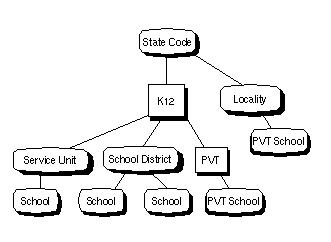
Technical and Vocational schools usually offer courses and training leading to specific specialized skills in a particular subject or technology.The naming structure for community colleges and technical/vocational schools in the form:
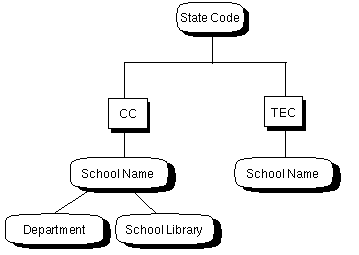
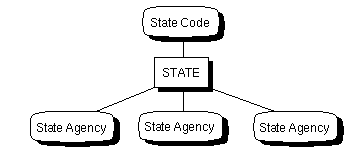

 Special Domain Names
Special Domain Names
-- CI - City Government Agencies
This branch is a subdomain under the <locality> name
(like Santa-Monica) for the city government. For example:
Fire-Dept.CI.Santa-Monica.CA.US.
-- CO - County Government Agencies
This branch is a subdomain under the <locality> name
(like San-Bernardino) for the county government. For example:
Fire-Dept.CO.San-Bernardino.CA.US
-- PVT - Private Schools
A special name "PVT" may be used in the place
of a school district name for private schools. For example:
<school-name>.PVT.K12.<state-code>.US.

 Registration:
Registration: All K12 schools, community colleges/technical schools, and state and local government agencies are encouraged to register under the US Domain. For registration in other top level domains such as COM, NET, and ORG see the ICANN web site at http://www.icann.org for a list of all current registrars, for EDU contact Network Solutions, Inc. at http://www.netsol.com, and for GOV contact registration@fed.gov.
To request a copy of the US Domain Template, send a message to the us-domain@isi.edu or use the template available online.
If you are registering a name in a zone that has been delegated, please mail your registration directly to the contact for the subdomain in which you want to register. The contact list for the subdomains delegated is available at Delegated Subdomains and their Contacts.
 Delegation:
Delegation:Acceptable locality names are those listed in the US Postal Service Zip Code Directory or a well-known atlas.
Organizations requesting delegations must provide at least two independent (robust and reliable) DNS name servers in physically separate locations on the Internet. The servers should be active and responsive to DNS queries BEFORE the application is submitted. Incomplete information about the servers and IP addresses or inactive servers will result in delay of the registration. The subdomain administrator must accept all applicants on an equal basis and provide timely processing of requests.
You must set your host computers to accept zone transfers from the US Domain Registry.
The subdomain manager must notify the US Domain Registrar immediately about any changes in the name servers that should be reflected in the US Domain zone files, or changes in the administrative and technical contact information. Administrators must follow the guidelines in the current US Domain RFC and assist applicants in selecting a domain name.
The contact phone number given to the US Domain Registrar should be answered during normal business hours. All messages received after business hours should be answered the next working day. This is required to resolve problems either by US Domain or by the customer directly. If we receive many complaints or experience any problems ourselves in getting touch with the delegated manager the delegation may be revoked.
Some domain managers have more 50 localities in one state. Those delegations were done prior to this rule. The above rule cannot be applied to those managers.
For delegations (or redelegations) made after 1-Jul-97, it is assumed by the US Domain Administrator that every applicant for the delegation (or redelegation) of a locality name has the written agreement of the legitimate government for that locality for the applicant to manage the domain name of that locality.
Evidence of such an agreement does not need to be presented at the time of delegation (except that the administrative contact on the application template must be the government representative). However, if the delegation is later challenged or contested, the manager of the locality domain must produce the agreement. Failure to do so will most likely result in the transfer of the management of the locality domain to another manager that does have such an agreement.
If there is a dispute as to who is the legitimate government for a locality and who may act for it, the league of cities or association of municipalities in that state (as recognized by the National League of Cities) may be asked to assist in resolving such disputes.
In some places there are overlapping jurisdictions with the same name (for example, the city of Los Angeles and the county of Los Angeles). In such cases, the higher level government should have priority.
One situation that occurs is that one individual represents himself as several distinct companies in order to bypass some limitations on the number of delegations allowed (e.g., the 50/500 rule).
Another situation is with the requirement to provide a government employee as the administrative contact for a locality delegation. Some applications have been received with a government employee's contact information but that person has no idea that such an application has been submitted. Some applications provide contact information for an individual that knows what is going on but is not an employee of the locality government. Still other applications have been received where the administrative contact information is fictional.
The US Domain Registrar may choose to verify any or all of the information on registration applications (including the administrative contact) and if it is determined that the an application contains false or substantially misleading information that application may be denied, or if already acted on the delegation may be revoked, and in either case all other delegations made to the party submitting the false or misleading application may also be revoked.
The special domains (K12, CC, TEC, LIB, MUS, STATE, DST, COG and GEN) under each state are established for special purposes (defined in RFC 1480 ).
In addition to the constraint to use them only for the defined purpose, each of these special domains is also delegated only to a manager within the state, and the operation of the delegated registry should be non-profit.
The LIB and MUS domains should be managed by a govermental or educational institution.
Further, it is most appropriate for the K12, CC, and TEC, domains to be managed by an educational organization (for example, a university or a department of education).
The STATE domain is most appropriately managed by an agency of the state government. DST and COG should be managed by a goverment agency.
The GEN domain may be delegated to a state organization that will provide the registration service for free (the purpose of GEN is to register statewide non-profit organizations). If we determine that these domains are being charged for, then all the domains delegated to that organization will be taken back. The same organization cannot have the delegation of GEN for two states.
 WHOIS:
WHOIS:The US Domain Registry has installed a client/server RWHOIS protocol to support the US Domain WHOIS information. We request that the administrator of a subdomain of the US Domain should also operate a RWHOIS server for those subdomains under them. For more information contact us-domain@isi.edu. The data from the information you supplied on your application will be used for your WHOIS entry. Currently, we provide third-level delegations in the US Domain WHOIS database. For example: K12.IL.US would have an entry in the US WHOIS database:
The RWHOIS for domains under .US is maintained by the US Domain Registry and not by the InterNIC.
The WHOIS information for IP addresses and most nameservers are maintained by the InterNIC. To modify those please email hostmaster@internic.net.
 Cost:
Cost:Most managers of delegated branches do not charge for registering a host in the US domain in their localities, though some do. There is no requirement that domain names be free, only that any charges be fair and applied equally to all customers.
In the past, managers provided the nameservers and registration services for localities (and other branches of the US domain) for free. Some people came forward to provide this public service, and it is very much appreciated.
Many locality names in the US domain are delegated to small companies. These companies need to charge a small fee to set up and maintain the database and run the nameservers to support this service.
In the current environment of the Internet, it is reasonable for locality managers to charge a small fee for domain name service under the US domain delegations.
Each locality domain manager is responsible for setting his own fees or billing practices and deciding what is "small". For example, some of these companies are charging $10 per year.
In a some instances, a domain name previously allocated by the US Domain administrator may be passed on to a new locality manager during delegation. The new administrator of the locality has to notify such name holders one year in advance before charging for those domains.
~~~~~~~~~~~~~~~~~~~~~~~~~~~~~~~~~~~~~~~~~~~~~~~~~~~~~~~~~~~~~~~~~~~~~~~~~

Go to ISI's home page.

Please send mail regarding any
problems or suggestions about this page to
the US Domain Registry. Thank you. Last modified 25-Oct-99.
